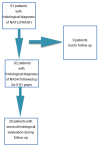Nonalcoholic Steatohepatitis: A 9-Year Follow Up Cohort Study
- PMID: 36233834
- PMCID: PMC9573625
- DOI: 10.3390/jcm11195969
Nonalcoholic Steatohepatitis: A 9-Year Follow Up Cohort Study
Abstract
Background and aim: Non-alcoholic fatty liver disease (NAFLD) may progress to severe liver fibrosis and cirrhosis. A limited number of studies with a long follow up assessed fibrosis progression and related predictors in untreated patients with a histological diagnosis of NAFLD. This study aims to investigate rate and predictors of NAFLD progression.
Methods: For 9 (2-16.7) years, we followed up a cohort of patients histologically diagnosed. Disease progression was defined by a composite endpoint as evidence of cirrhosis in patients without cirrhosis at baseline, evidence of de novo occurrence of cirrhosis complications, histologically established worsening of stage 1 of fibrosis or increase of 20% in liver stiffness by transient elastography in patients rejecting a second liver biopsy.
Results: A total of 91 patients were enrolled. Of them, 31 had NAFL and 60 NASH. A second liver biopsy was performed in 22 NASH patients and in 4 NAFL. Disease progression was observed in 38.5% NASH and in 12.0% NAFL (p = 0.034). Patients with portal inflammation had a higher risk of progression (66.7% vs 26%, p = 0.021). High triglycerides levels, advanced fibrosis at baseline and the duration of follow-up predict disease progression (p = 0.021; OR = 6.93, 95% CI 1.33-36.08, p = 0.43; OR 8.37; 95% CI 1.07-65.58 and p = 0.034; OR = 0.88; 95% CI 0.78-0.99, respectively).
Conclusions: Our results reinforce the evidence that, in the absence of pharmacologic treatment, NASH progresses in about 40% of patients. Liver biopsy is the only mean to discriminate NAFL from NASH. The prognostic role of portal inflammation needs to be explored in larger series.
Keywords: NASH; cirrhosis; fibrosis; liver histology; non-invasive diagnosis.
Conflict of interest statement
The authors declare no conflict of interest.
Figures




References
-
- Younossi Z.M., Golabi P., de Avila L., Paik J.M., Srishord M., Fukui N., Qiu Y., Burns L., Afendy A., Nader F. The global epidemiology of NAFLD and NASH in patients with type 2 diabetes: A systematic review and meta-analysis. J. Hepatol. 2019;71:793–801. doi: 10.1016/j.jhep.2019.06.021. - DOI - PubMed
LinkOut - more resources
Full Text Sources

